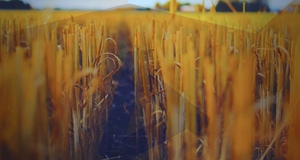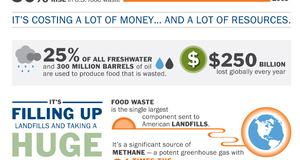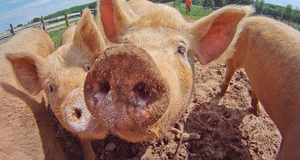From Earth Common Journal VOL. 3 NO. 1The Price of Development: The Importance of Preserving Local Agricultural LandsUnsustainable Disconnect with Producers and our FoodConsidering the risks posed by our current food industry as it is, it is a wonder that so many people are still unaware of the importance of making changes to our food industry by supporting local producers as well as protecting and preserving their land from the threat of urban expansion, to ensure they continue operating. This is important because not only does industrialized agriculture increase the distance our food travels it also decreases our connection to our food by taking it out of our awareness. This leaves many of us oblivious to the dangers we face if our food industry continues as it has been. The Slow Movement (2013), an organization that provides information and opportunities to encourage a sustainable way of life, sheds light on the fact that, We are losing farmers every year, and rural communities are deteriorating socially and economically. Children are growing up not knowing where their food comes from – not just where it is produced but also how it is produced. Some children are unaware that carrots grow under the ground and tomatoes on plants above ground. They have lost connection to their food (para. 3). This places focus on the importance of a relationship between community and local agriculture. The Hebert family, owners and operators of Riverbend Gardens, recognize the importance of a need to create a connection between the community and the land. In an “effort to develop an agricultural relationship with community members” (Riverbend Gardens, 2013, para. 1) they offer a variety of produce at farmer’s markets across the Edmonton area. At their greenhouses they also offer U Pick Saskatoons for those who enjoy harvesting their own food, and for local backyard gardeners they grow a “variety of tomatoes suitable to the Edmonton climate” (Riverbend Gardens, 2013, para.3), as well as providing information and support on how to properly care for a garden. In addition to the local farmer’s markets, Riverbend Gardens delivers fresh seasonal produce through the Community Supported Agriculture (CSA) program. According to CSA member, Elizabeth Bunney Lakoseljac, the program supports an agricultural relationship between Riverbend Gardens and the community, as CSA members “invest in their farm with the promise of receiving a bounty when the crops are ready” (Elizabeth interview, July, 15, 2013). And the benefits of such a relationship is not only one-sided. Elizabeth Bunney-Lakoseljac credits her involvement in the CSA as having improved and expanded her family’s diet. “We have access to fresh vegetables every week and we find that we eat a lot more vegetables because of it. We are also eating things we hadn’t used before, like kohlrabi and fennel. They taste so fresh – everything tastes better than what is at the grocery store” (Elizabeth interview, July, 15, 2013). But that is not where the community relationship ends. Riverbend Gardens also regularly provide fresh produce to local agencies such as the Mustard Seed church, as well as running fundraisers in support of their operation (Riverbend Gardens, 2013, para 1). The connection between Riverbend Gardens and all levels of the community run deep, and as such, preserving the land and the livelihood of this local producer should be paramount above the needs of urban sprawl. ConclusionWithout community and government support towards movements for preserving agricultural land, small producers, like Riverbend Gardens, will continue to disappear until only industrialized single crop producers remain. The consequences of this put people and the environment at risk of continued exposure to chemical pesticides, increased food costs, and continued environmental pollution and degradation. Pushing out local farmers in favour of urban sprawl attributes to already rising food costs by reducing, if not almost eliminating people’s choices for locally grown produce. This further contributes to the larger global food crisis by putting us at risk of being “only another US drought, South American drought or big episode in one of the main producers away from another big spike in food prices” (McGuiness, 2013, para. 20). ReferencesCarson, Rachel. Silent Spring. Boston: The Riverside Press Cambridge, 1962. Print Centre for Environmental Education. (2008). How School Food Affects the Environment. Retrieved August 10, 2013, from http://www.ceeonline.org/greenGuide/food/upload/environmenthealth.aspx Dick, Lyle and Jeff Taylor. (2012). History of Agriculture. Historica Canada. Retrieved July 30, 2013, from http://www.thecanadianencyclopedia.com/articles/history-of- agriculture Elton, Sarah. Consumed: Food for a Finite Planet. 2013. HarperCollins Publishers Ltd. Toronto, ON. Print Health and Environmental Effects of Pesticides. (n.d.). Pdf. Retrieved July 27, 2013, from http://www.toronto.ca/health/hphe/pdf/ps_effects.pdf Lucas, Caroline, Andy Jones, and Colin Hines. Peak Oil and Food Security: Fuelling a Food Crisis. Part One. (Winter 2007). Pacific Ecologist. McGuiness, Ross. (2013, April 13). Build a Sustainable Food Source: How Will We Feed 9 Billion People on the Planet in 2050. Metro News. Retrieved August 8, 2013, from http://metro.co.uk/2013/04/03/building-a-sustainable-food-source-how- will-we-feed-9-billion-people-on-the-planet-in-2050-3579801/ Messenger, Scott. (July 30, 2013). Paving Paradise. Avenue. Retrieved August 12, 2013, from http://www.avenueedmonton.com/articles/paving-paradise Natural Resources Defense Council. (2008, July 25). Vanishing Bees. Retrieved August 8, 2013, from http://www.nrdc.org/wildlife/animals/bees.asp Notras, Mark. (2010, June 30). Agriculture and Food Sources Unsustainable. Our World 2.0. United Nations University. Web Retrieved July 15, 2013, from http://ourworld.unu.edu/en/agriculture-and-food-systems-unsustainable/ Pesticides and Chemicals that Impact Agriculture. (n.d.). [Pdf Report]. Retrieved July 30, 2013, from http://www.diversifiedlaboratories.com/PestsandChemsAgr.pdf Riverbend Gardens. (2013, Summer). About Us. Retrieved August 5, 2013, from http://www.riverbendgardens.ca/about.html Riverbend Gardens. (2013, Summer). Home. Retrieved August 5, 2013, from http://www.riverbendgardens.ca/about.html Riverbend Gardens. (2013, Summer). Products. Retrieved August 5, 2013, from http://www.riverbendgardens.ca/about.html Slow Movement. (2013). What are Community Food Systems. Retrieved August 11, 2013, from http://www.slowmovement.com/cfs.php Stanford, Malcolm, T., (2013). Protecting Honey Bees from Pesticides. Retrieved July 30, 2013, from http://edis.ifas.ufl.edu/aa145 United States Environmental Protection Agency. (1999, Aug 2). Methyl Parathion Risk Management Decision: Regulatory Actions. Retrieved March 18, 2011, from http://www.epa.gov/pesticides/factsheets/chemicals/mpfactsheet.htm Watts, Meriel, Dr. (2008, October). Methyl Parathion Monograph. Pdf. Retrieved August 5, 2013, from http://www.panap.net/sites/default/files/monograph_methyl_parathion.pdf Witford, Fred, Brian Miller, Richard Bennett, Margaret Jones, and Larry Bledsoe. (n.d.). Pesticides and Wildlife. Purdue Pesticide Programs. Retrieved August 10, 2013, from http://www.ppp.purdue.edu/Pubs/ppp30.html Suggested Reading from Inquiries Journal
Inquiries Journal provides undergraduate and graduate students around the world a platform for the wide dissemination of academic work over a range of core disciplines. Representing the work of students from hundreds of institutions around the globe, Inquiries Journal's large database of academic articles is completely free. Learn more | Blog | Submit Latest in Environmental Studies |



















